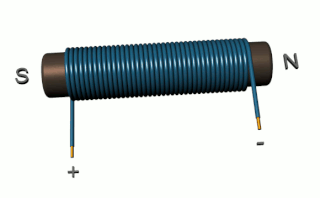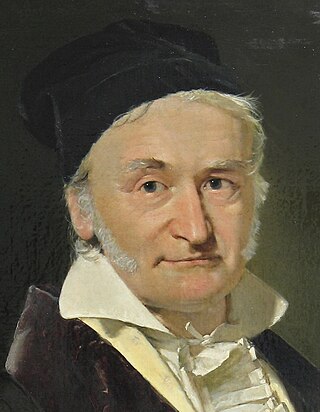Related Research Articles

The ampere, often shortened to amp, is the unit of electric current in the International System of Units (SI). One ampere is equal to 1 coulomb (C) moving past a point per second. It is named after French mathematician and physicist André-Marie Ampère (1775–1836), considered the father of electromagnetism along with Danish physicist Hans Christian Ørsted.

An electric current is a flow of charged particles, such as electrons or ions, moving through an electrical conductor or space. It is defined as the net rate of flow of electric charge through a surface. The moving particles are called charge carriers, which may be one of several types of particles, depending on the conductor. In electric circuits the charge carriers are often electrons moving through a wire. In semiconductors they can be electrons or holes. In an electrolyte the charge carriers are ions, while in plasma, an ionized gas, they are ions and electrons.
The centimetre–gram–second system of units is a variant of the metric system based on the centimetre as the unit of length, the gram as the unit of mass, and the second as the unit of time. All CGS mechanical units are unambiguously derived from these three base units, but there are several different ways in which the CGS system was extended to cover electromagnetism.

In physics, electromagnetism is an interaction that occurs between particles with electric charge via electromagnetic fields. The electromagnetic force is one of the four fundamental forces of nature. It is the dominant force in the interactions of atoms and molecules. Electromagnetism can be thought of as a combination of electrostatics and magnetism, which are distinct but closely intertwined phenomena. Electromagnetic forces occur between any two charged particles. Electric forces cause an attraction between particles with opposite charges and repulsion between particles with the same charge, while magnetism is an interaction that occurs between charged particles in relative motion. These two forces are described in terms of electromagnetic fields. Macroscopic charged objects are described in terms of Coulomb's law for electricity and Ampère's force law for magnetism; the Lorentz force describes microscopic charged particles.

A magnetic field is a physical field that describes the magnetic influence on moving electric charges, electric currents, and magnetic materials. A moving charge in a magnetic field experiences a force perpendicular to its own velocity and to the magnetic field. A permanent magnet's magnetic field pulls on ferromagnetic materials such as iron, and attracts or repels other magnets. In addition, a nonuniform magnetic field exerts minuscule forces on "nonmagnetic" materials by three other magnetic effects: paramagnetism, diamagnetism, and antiferromagnetism, although these forces are usually so small they can only be detected by laboratory equipment. Magnetic fields surround magnetized materials, electric currents, and electric fields varying in time. Since both strength and direction of a magnetic field may vary with location, it is described mathematically by a function assigning a vector to each point of space, called a vector field.

The coulomb (symbol: C) is the unit of electric charge in the International System of Units (SI). It is equal to the electric charge delivered by a 1 ampere current in 1 second and is defined in terms of the elementary charge e, at about 6.241509×1018 e.
The oersted is the coherent derived unit of the auxiliary magnetic field H in the centimetre–gram–second system of units (CGS). It is equivalent to 1 dyne per maxwell.

An electromagnet is a type of magnet in which the magnetic field is produced by an electric current. Electromagnets usually consist of wire wound into a coil. A current through the wire creates a magnetic field which is concentrated in the hole in the center of the coil. The magnetic field disappears when the current is turned off. The wire turns are often wound around a magnetic core made from a ferromagnetic or ferrimagnetic material such as iron; the magnetic core concentrates the magnetic flux and makes a more powerful magnet.
The ampere-turn is the MKS (metre–kilogram–second) unit of magnetomotive force (MMF), represented by a direct current of one ampere flowing in a single-turn loop. Turns refers to the winding number of an electrical conductor composing an electromagnetic coil. For example, a current of 2 A flowing through a coil of 10 turns produces an MMF of 20 A⋅t. The corresponding physical quantity is N⋅I, the product of the number of turns, N, and the current, I; it has been used in industry, specifically, US-based coil-making industries.

Inductance is the tendency of an electrical conductor to oppose a change in the electric current flowing through it. The electric current produces a magnetic field around the conductor. The magnetic field strength depends on the magnitude of the electric current, and follows any changes in the magnitude of the current. From Faraday's law of induction, any change in magnetic field through a circuit induces an electromotive force (EMF) (voltage) in the conductors, a process known as electromagnetic induction. This induced voltage created by the changing current has the effect of opposing the change in current. This is stated by Lenz's law, and the voltage is called back EMF.

Gaussian units constitute a metric system of physical units. This system is the most common of the several electromagnetic unit systems based on cgs (centimetre–gram–second) units. It is also called the Gaussian unit system, Gaussian-cgs units, or often just cgs units. The term "cgs units" is ambiguous and therefore to be avoided if possible: there are several variants of cgs with conflicting definitions of electromagnetic quantities and units.
The abcoulomb or electromagnetic unit of charge is the derived physical unit of electric charge in the cgs-emu system of units. One abcoulomb is equal to ten coulombs.
Heaviside–Lorentz units constitute a system of units and quantities that extends the CGS with a particular set of equations that defines electromagnetic quantities, named for Oliver Heaviside and Hendrik Antoon Lorentz. They share with the CGS-Gaussian system that the electric constant ε0 and magnetic constant µ0 do not appear in the defining equations for electromagnetism, having been incorporated implicitly into the electromagnetic quantities. Heaviside–Lorentz units may be thought of as normalizing ε0 = 1 and µ0 = 1, while at the same time revising Maxwell's equations to use the speed of light c instead.
The vacuum magnetic permeability is the magnetic permeability in a classical vacuum. It is a physical constant, conventionally written as μ0. It quantifies the strength of the magnetic field induced by an electric current. Expressed in terms of SI base units, it has the unit kg⋅m⋅s−2·A−2. It can be also expressed in terms of SI derived units, N·A−2.
The abohm is the derived unit of electrical resistance in the emu-cgs (centimeter-gram-second) system of units. One abohm corresponds to 10−9 ohms in the SI system of units, which is a nanoohm.
The metre, kilogram, second system of units, also known more briefly as MKS units or the MKS system, is a physical system of measurement based on the metre, kilogram, and second (MKS) as base units. Distances are described in terms of metres, mass in terms of kilograms and time in seconds. Derived units are defined using the appropriate combinations, such as velocity in metres per second. Some units have their own names, such as the newton unit of force which is the combination kilogram metre per second squared.
The abvolt (abV) is the unit of potential difference in the CGS-EMU system of units. It corresponds to 10−8 volt in the SI system and 1/ccgs statvolt ≈ 3.3356×10−11 statvolt in the CGS-ESU system.
The International System of Electrical and Magnetic Units is an obsolete system of units used for measuring electrical and magnetic quantities. It was proposed as a system of practical international units by unanimous recommendation at the International Electrical Congress, discussed at other Congresses, and finally adopted at the International Conference on Electric Units and Standards in London in 1908. It was rendered obsolete by the inclusion of electromagnetic units in the International System of Units (SI) at the 9th General Conference on Weights and Measures in 1948.
The statampere (statA) is the derived electromagnetic unit of electric current in the CGS-ESU and Gaussian systems of units.:278 One statampere corresponds to 10/ccgs ampere ≈ 3.33564×10−10 ampere in the SI system of units.
References
- 1 2 Gyllenbok, Jan (2018). Encyclopaedia of Historical Metrology, Weights, and Measures: Volume 1. Birkhäuser. ISBN 978-3-319-57598-8.
- ↑ Cook, James L. (1991). Conversion Factors. Oxford University Press. ISBN 978-0-19-856349-5.
- ↑ A.E. Kennelly (1903) "Magnetic units and other subjects that might occupy attention at the next international electrical congress" 20th Annual Convention of the American Institute of Electrical Engineers, 1903